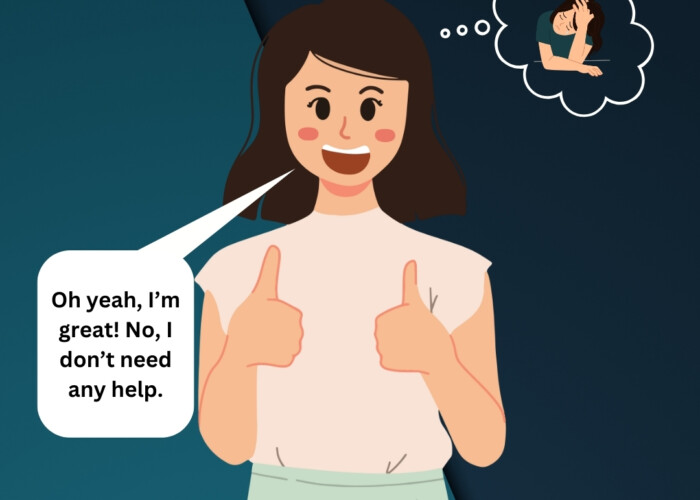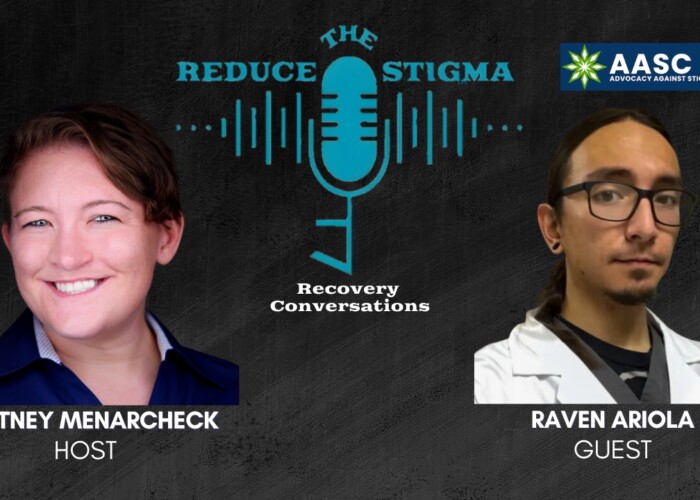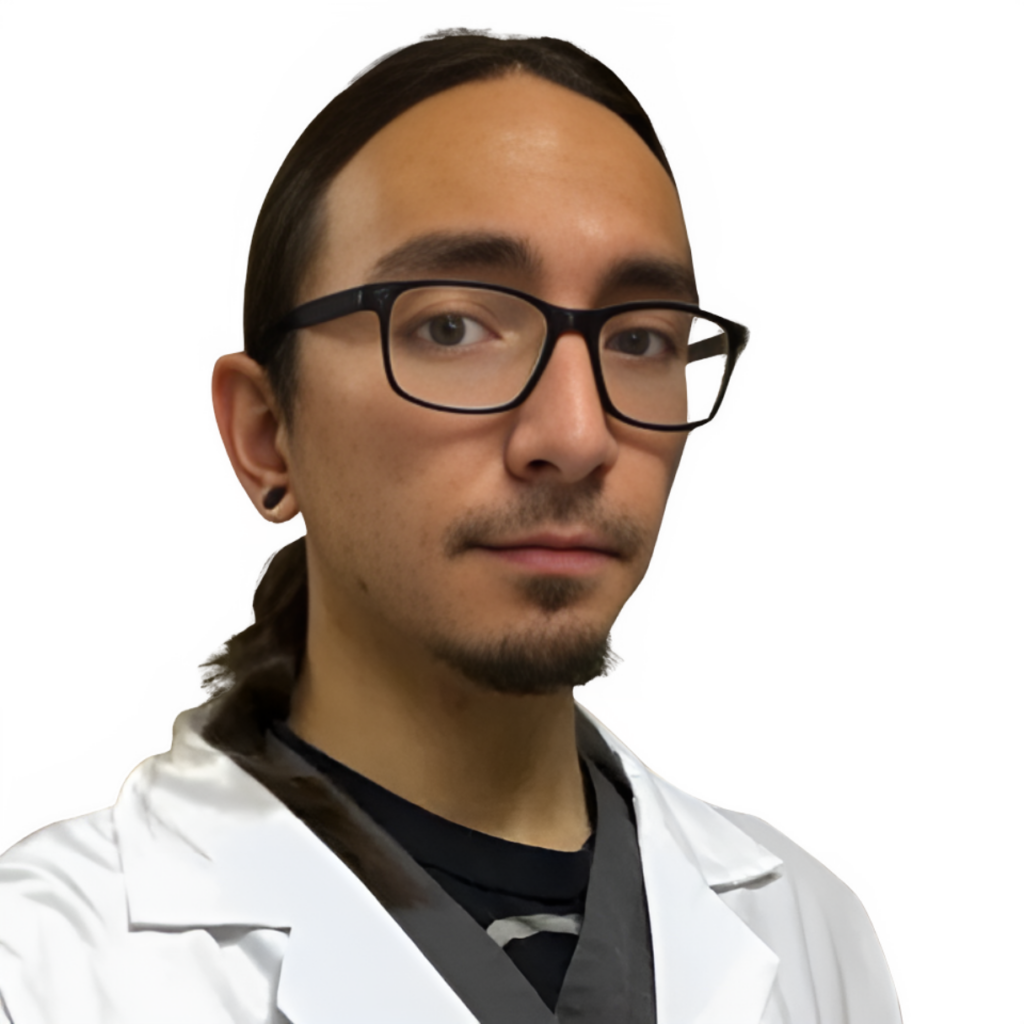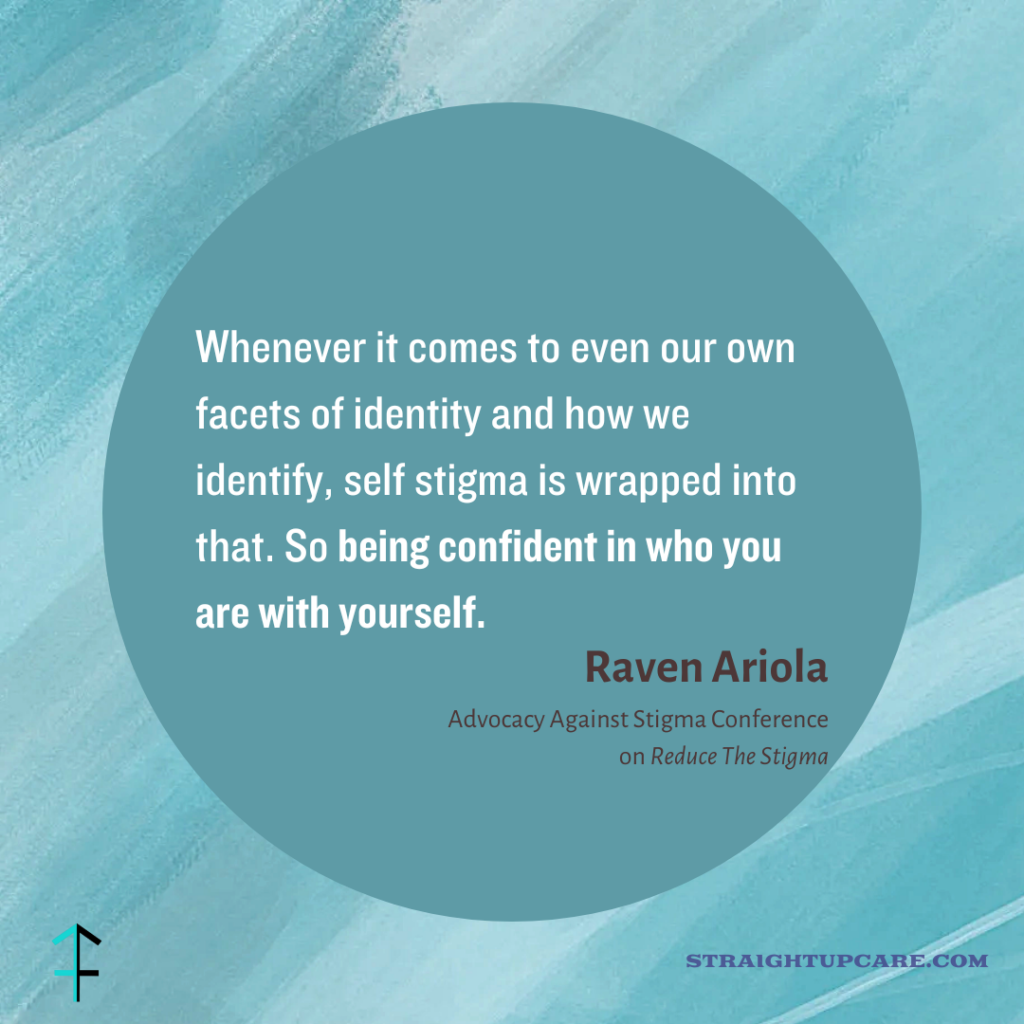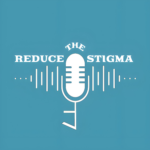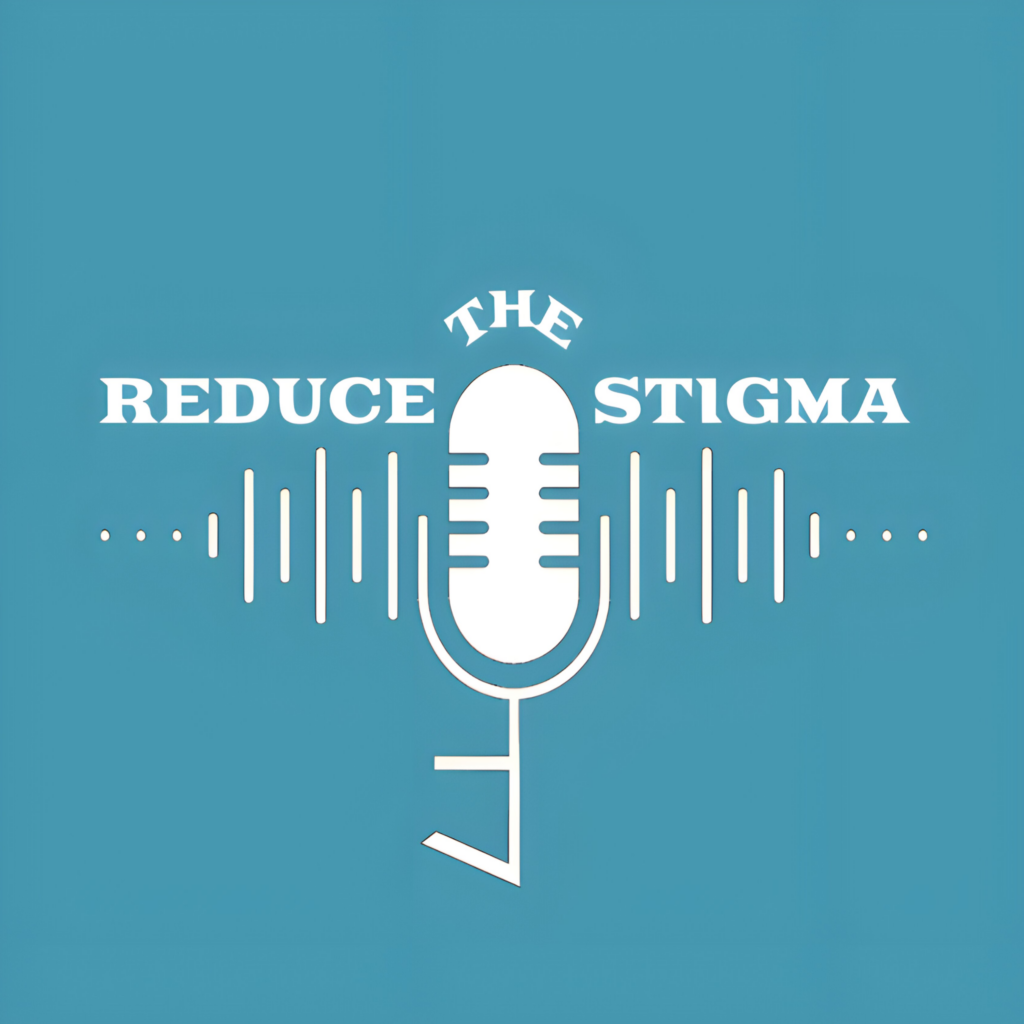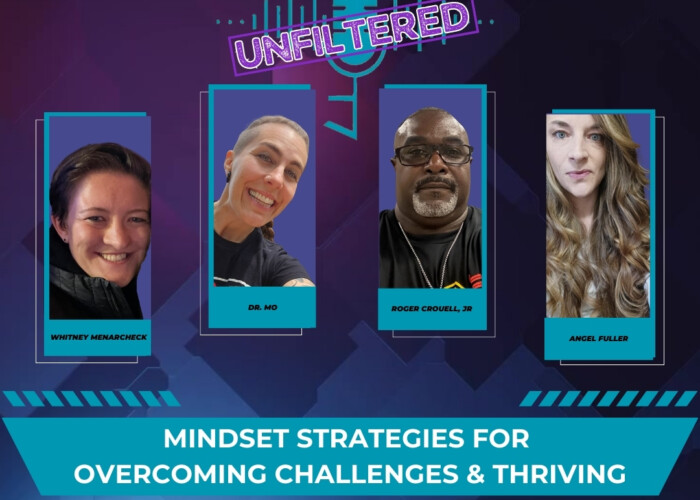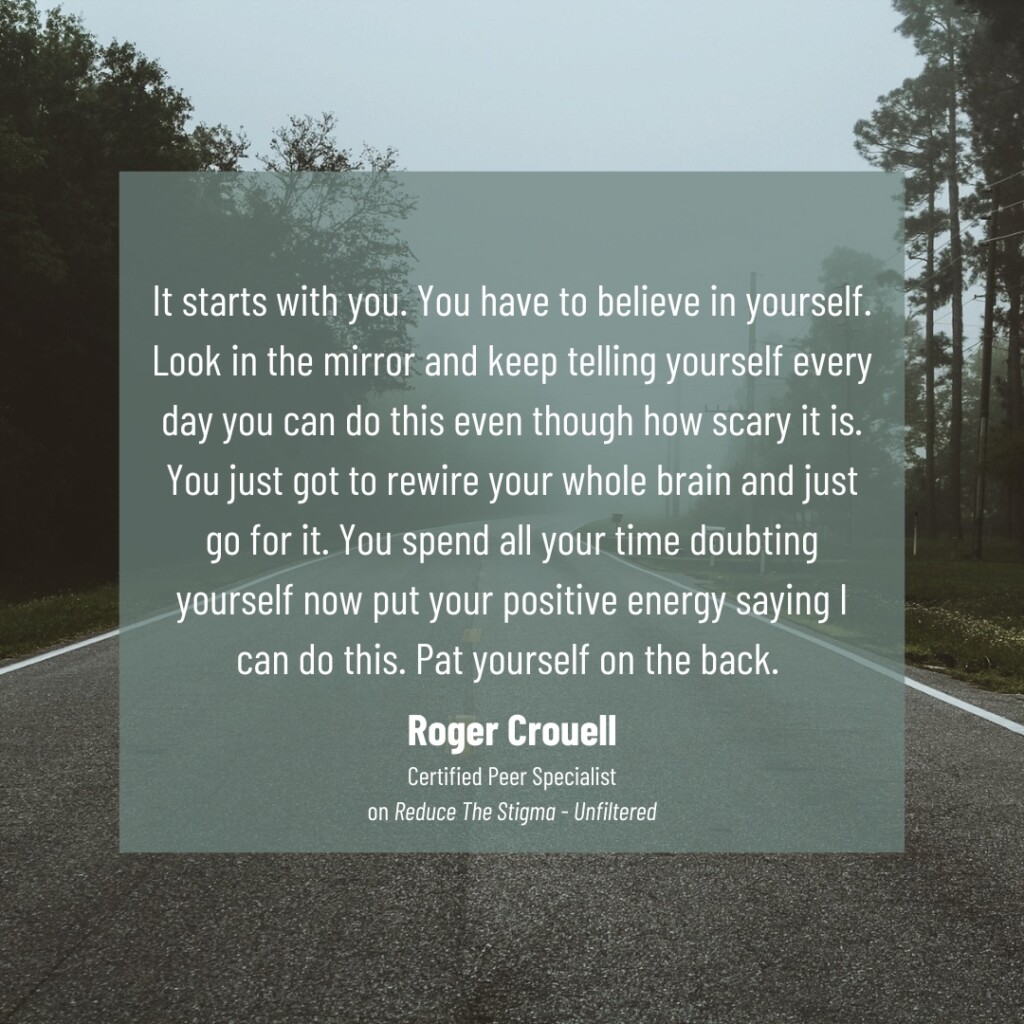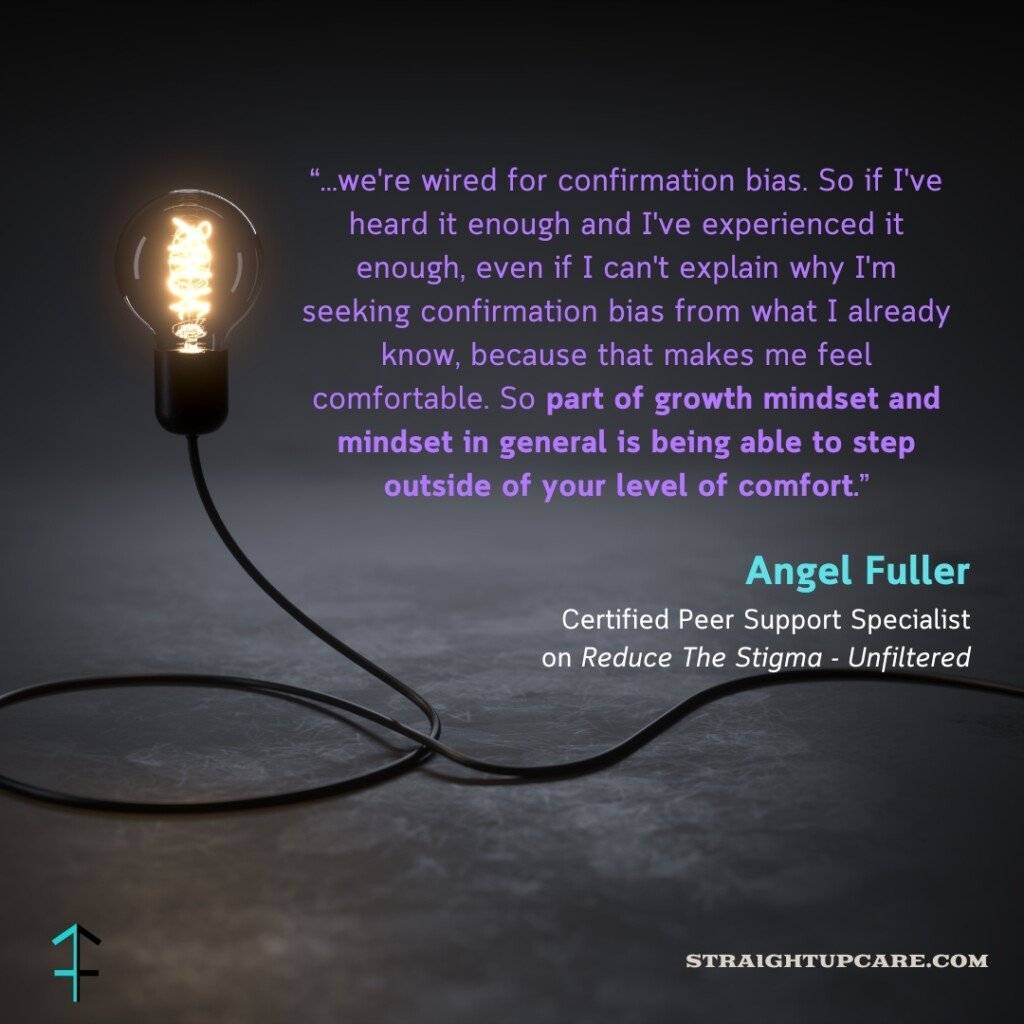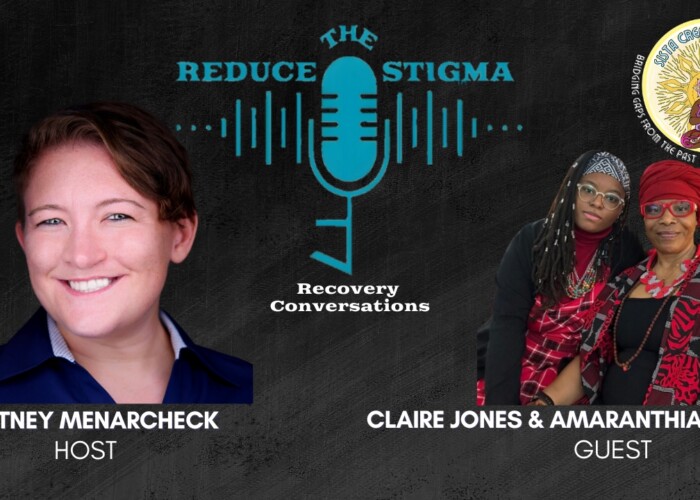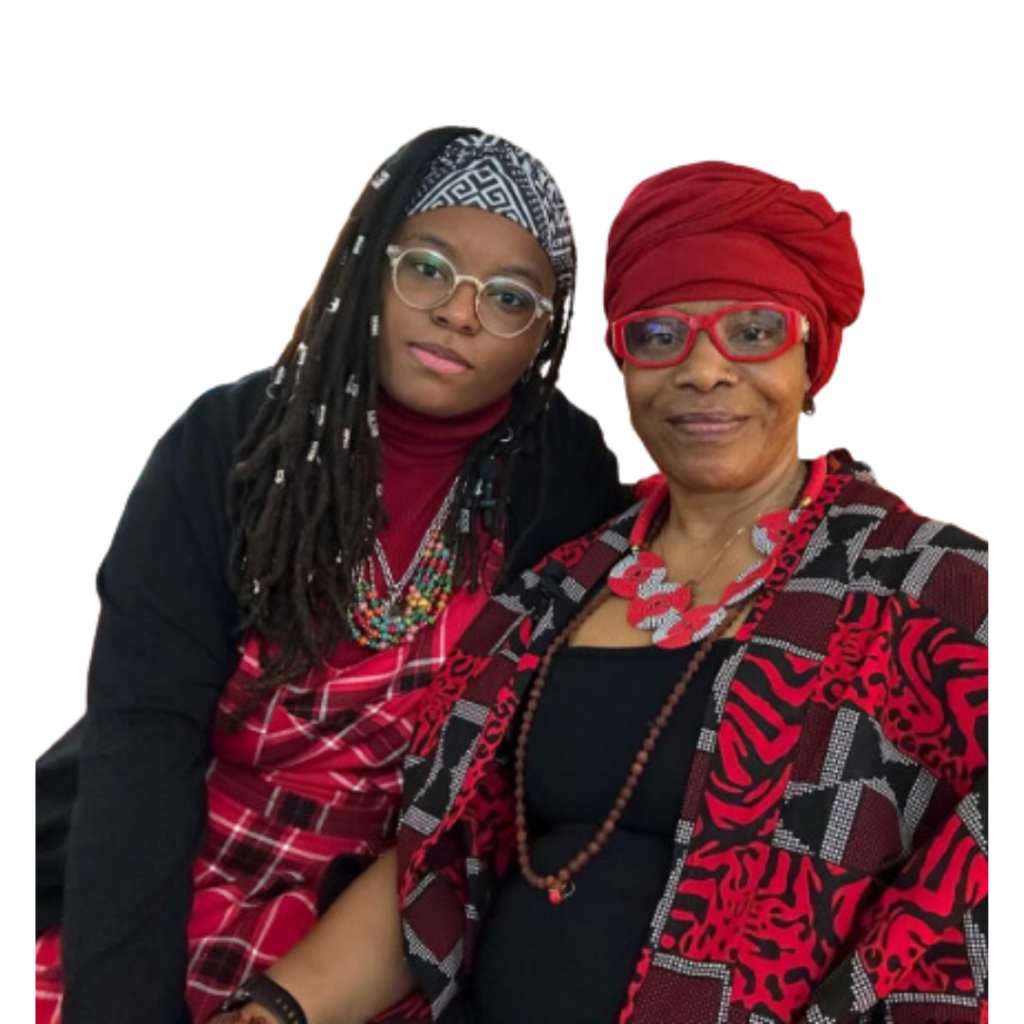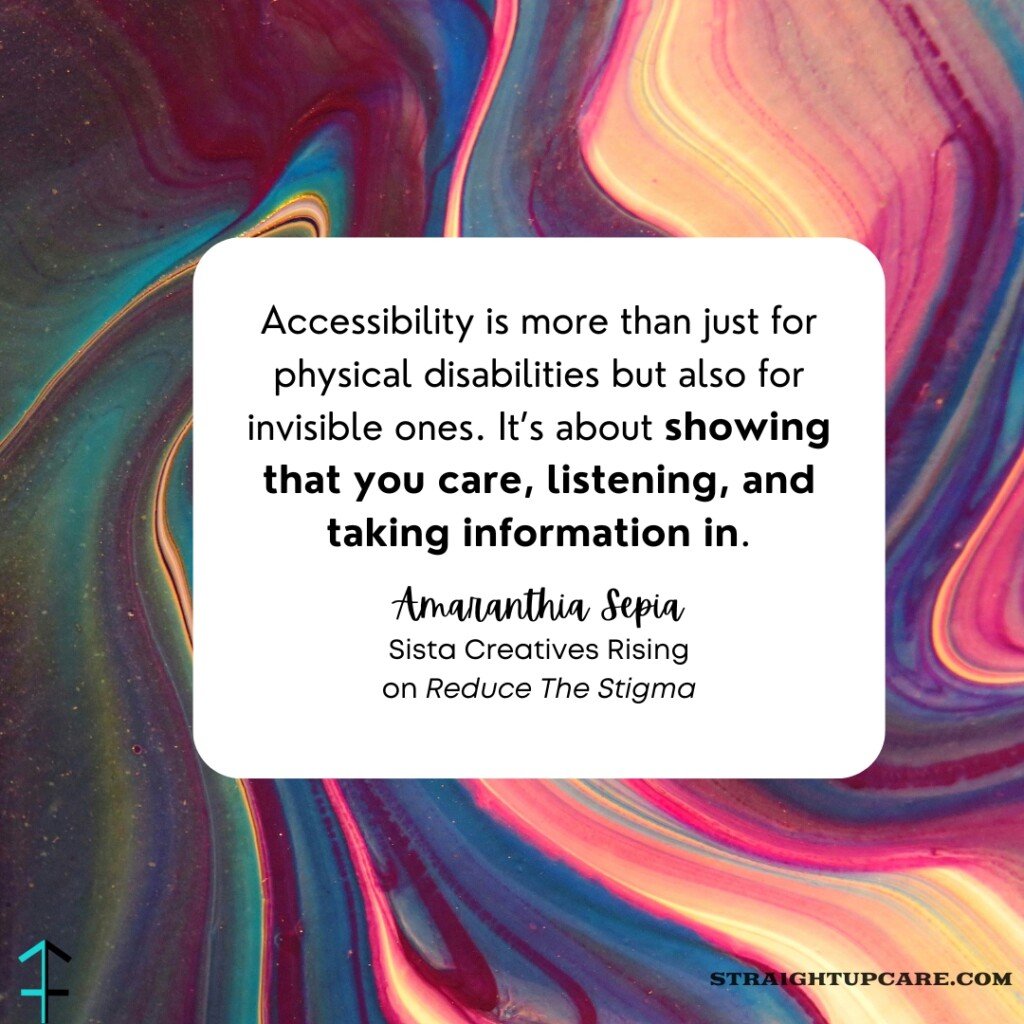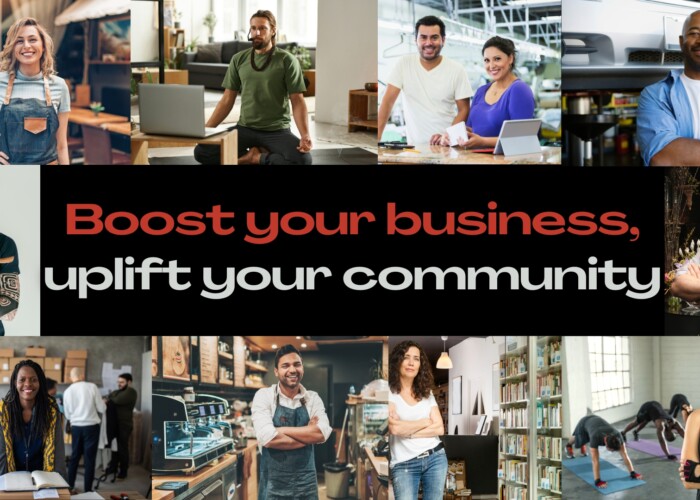Whitney | She/Her (00:00)
Welcome everybody. This is the very first live stream show of Reduce the Stigma.
And Reduce the Stigma is brought to all of you by Straight Up Care, the comprehensive telehealth platform for peer support services. No matter what you’re going through, there’s a peer specialist ready to support you. Visit Straight Up Care, where recovery is powered by lived experience. And today’s episode is in particular sponsored by Syndicate 12.
Syndicate 12 is an online recovery community and social media platform designed exclusively for those with mental health or substance use lived experience. With live chat rooms, contests, posts, and more, you earn points for taking care of your recovery and then can redeem them for great rewards. We’re all headed over to Syndicate 12 because together recovery is possible. I’m your host, Whitney Menarcheck, and with me today, I have such a great group.
and I’m gonna let them introduce themselves here in a moment. Before we do that though, we just launched this segment. We already have two, we have Recovery Conversations and Meet the Peer, and today we are starting our new segment. We ran a contest and we had some great suggestions and I’m excited to share that the new segment, this segment, will be called Reduce the Stigma Unfiltered because we’re gonna have those tough conversations that go.
deep into the things that most people are too nervous or maybe it’s kind of taboo to talk about, but we want to reduce the stigma around everything. And that’s what we’re doing here at Reduce the Stigma. So I’m going to first ask Dr. Mo, can you introduce yourself and tell us why are we talking about mindset if we’re a podcast that is going to explore taboo topics?
Dr. Mo (01:55)
Yeah, absolutely. So I am Dr. Mo I’m the CEO of Straight Up Care and I’m super happy to be here on Unfiltered. So the reason we start with mindset is, I mean, where does everything start, right? It’s how we think about things, how we understand things, our perceptions, the way we take things in. And so I think if we don’t start talking about mindset, the way we think about things, our biases, and how things really look through our lens, then we’re not.
doing ourselves justice for the hard conversations that we’re having coming forward. So we thought if we started with mindset and being able to understand and intake and know that we can learn and unlearn things, then we would be doing ourselves a disservice. So here we are on Unfiltered talking about mindset first.
Whitney | She/Her (02:38)
Thank you so much, Dr. Mo. And with us today, we have two incredible peer specialists that really are setting incredible examples of how to implement a healthy mindset and use that mindset to overcome challenges and be successful in your life. So I’m gonna go ahead and ask Angel, please introduce yourself.
Angel Fuller (03:00)
Hi, I’m Angel. I’m a North Carolina peer support and I’ve been working with a Straight Up Care -up care, I think, since the beginning. So I’m really excited to be here and hopefully we can all grow together.
Whitney | She/Her (03:18)
Thank you, and Roger.
Roger Crouell (03:21)
My name is Roger Cruell I’m another one certified pit support specialist here with Straight Up Care Care, and I’m just glad to be here. Glad to be here.
Whitney | She/Her (03:29)
We’re glad to have you both and we’re hopefully gonna learn more about you as we go through. And everyone in the audience, please feel free to submit your questions because we’re here to talk about what you wanna talk about. And so to get things started, because we are talking about mindset, I’m gonna go ahead and ask you, Angel, what, you know, mindset’s a bit of a buzzword lately. In your words, what is mindset?
Angel Fuller (03:56)
mindset’s pretty broad. I guess it depends on who you ask. But for me, I’ll correlate back to what Dr. Mo said, perception, the way I see things because, and it’s also to me mindset is also growth though, because with the proper mindset we can grow what you don’t know, you can’t grow. So once I get in the mindset of growth and understanding, then I have two choices to move forward in that growth and understanding or to stay where I am.
Dr. Mo (04:20)
Thank you.
Angel Fuller (04:26)
So mindset for me is really one of the building blocks and foundations for being able to grow and move forward.
Whitney | She/Her (04:35)
Wonderful. That’s a great definition and really sets the stage for what we’re talking about. And like Dr. Mo said, we have to have that mindset to talk about these tough things. So Roger, where does mindset come in? You know, we’re a platform about lived experience, addiction, mental health, all those tough things. Why is it that mindset plays an important part?
Roger Crouell (05:00)
Because it controls the way you think, you feel, you behave. It pivots everything you do, how you see yourself. So once you do that, you’ll stop repeating what you do and involved in your situation.
Whitney | She/Her (05:17)
Yeah, absolutely. And you know, I’m curious, and this is both to anyone, Dr. Mo, you as well, what are some of the things that you do to tend to your mindset and maybe start the day in that right mindset?
Dr. Mo (05:36)
I’ll start. So we’ve recently started putting stickies on our mirror.
of something that we want to be reminded of. And I’m talking about me and my six year old daughter. And so last night she said, what are we, what are we putting on the wall tonight? And I was like, I don’t know what’s something we, you know, something we want to remember something that we’re whatever, you know, and she was like, I think we should put lucky up there. And I was like, what do you mean lucky? What does that mean? And so we ended up talking about gratitude and what gratitude looks like. And that if we think about things that are great in our lives, that brings more greatness to our lives. And we have this like awareness of greatness and what it looks like.
and how to magnify that. And so we turned lucky into gratitude, but that’s how I start my morning too. You know, I don’t know if anybody else does this, but I often reach for my phone, maybe to check what time, maybe to see how many, I don’t know, people have messaged me so I can get started. But before I reach for that phone, I spend a little bit of time, what am I grateful for? Because if that can be the first few thoughts that I have in the morning, then I can radiate that throughout the day. And so when I think about mindset and how I kind of strategically
place things in my path, that’s one of the things that I do.
Roger Crouell (06:47)
If I could pick it back off my doctor Moses I do I do some something similar They do things before I wake up in the morning. I listen at something spiritual now listen at some motivational you y ‘all probably see a lot of stuff I put in our platform or about the motivation because the first 15 minutes When you open your eyes the first 15 minutes of your date, that’s how you are. You can portray your outcome If you listen at something negative you tell your mind it’s gonna be negative. I don’t want to get up to go to work I don’t just it’s done cute you move
But if you put some positive in it, let’s go get it. The day is done. Go, go, go. Your day will get better. It will heighten that much.
Dr. Mo (07:27)
Absolutely.
Whitney | She/Her (07:27)
Nice. What about you, Angel?
Angel Fuller (07:29)
I think that for me, the first thing I do, honestly, when my feet touch the floor is I start my workout video. Now, it doesn’t sound like a good mindset motivation, but the program that I follow, one of the things that she says all the time is it’s you against you. So as soon as my feet hit the floor, I’m making the decision whether I’m gonna be productive in this activity because getting my body moving and taking that quality time to myself every morning is very important.
but not only that, it gives me the time to think about what post I’m going to put on social media today for my peer support, rise and thrive. And then when I get outside, after I do my sweating, thanks to Roger, I then listen to a motivational video for my entire walk. Okay. And by the time I get back in the house, I’m prepared to feed the kids and start the day and make sure that I’m being filled up enough in myself to be able to fill up other people because.
Whitney | She/Her (08:13)
Okay.
Angel Fuller (08:25)
I lived in a survival mode for so long. Even after I got cleaned and I got sober, it was just survival. And I told somebody one time, they said, well, why don’t you tell your story? And I said, for many years, I was just trying to rebuild my life. And I didn’t want to have to recommit to all the stuff that I had done to new people. I didn’t want to do that. So it took me a long time to get ready and prepared to be able to give of myself in all of what I had done.
to other people in a positive way. So listening to those things that Roger listens to every morning and telling me that, telling myself that I’m here against myself every day reminds me now and gets me in the mindset of wanting to help somebody else. Whereas I used to just want to help myself to survive.
Dr. Mo (09:14)
I love that. That means you’re thriving.
Angel Fuller (09:16)
I’m trying!
Roger Crouell (09:17)
Yes.
Dr. Mo (09:19)
I love it. So Angel, one thing that you said that I want to kind of jump back to.
When you first started talking about like mindset and how to how to shift your mindset and having that growth mindset I was reminded of Adam Grant’s book called think again and I use this in a lot of my classes and we talk about what does it look like to relearn things right so Amory was somebody who was on Whitney interviewed and a super awesome dude and he was talking about how he had to relearn What it looked like to go out and do things in public sober, right? He didn’t have to
to learn how to eat again, but he had to learn how to go out and do things again sober, right? And that’s a whole process that we don’t think about. And ever since I watched and listened to Whitney and Anne -Marie talk about this, I’ve been using this explanation often to help people understand a little bit more about what addiction and recovery, the part of recovery that it looks like, right? Like we are able to do these things, but it looked different, right? Anytime we make a large change,
We know how to do some of the things, but we really have to shift our mindset around it. And then what does it look like when we get new information? So if I give you a new research article that totally, you know, or maybe I give you three, let’s say three research articles that proven a new point, right? And your old mindset says, okay, but this thing is what I’ve been told and this is what I know. Okay. But now we have new information, so we have to make new memories. We have to start using that new information moving forward.
Angel Fuller (10:49)
Mm -hmm.
Dr. Mo (10:49)
I think sometimes people get really stuck in that, but this is what I already know and this feels comfortable for me, right? And I get it as humans, we don’t honestly like our brains are these wonderful machines, but they don’t actually want to think, right? They just kind of want to go and get the things done. And so we have to really push ourselves when it’s time to think, when it’s time to use new words. So I was talking about like, even today in class, we were talking about the shift in vocabulary with trans people. And even though maybe they then didn’t make
make sense to you at first, either you did a couple of things. You either started saying it because you knew it was the right thing to do and you wanted to make sure people felt included, or you started to think about it and understand it and they, them is plural. And maybe that’s because they feel like themselves as plural, right? And so understanding that these new language and new things happen and then we change and we shift, right? We do it all the time. We just kind of buck against it. But I think when we talk about mindset, we can’t be so stuck in it. Like you were saying, Angel, we have to be able to have this growth.
we can have our lens and that’s fabulous and amazing, but then how can we open up that lens to be able to shift when needed, to pivot where we see it’s time to pivot and to be respectful of other people if we’re talking about the other scenarios that I brought up. So that was kind of some of my takeaways from you as I heard you talk.
Angel Fuller (12:08)
Yeah, growth mindset and what you’re talking about learning to adhere to new material is we’re wired for confirmation bias. So if I’ve heard it enough and I’ve experienced it enough, even if I can’t explain why that we’re I’m seeking confirmation bias from what I already know, because that makes me feel comfortable. So part of growth mindset and mindset in general is being able to step outside of your level of comfort.
Whitney | She/Her (12:09)
in it.
Angel Fuller (12:37)
And it’s scary, which is why we don’t do it. I mean, if somebody told you go stick your hand in that water, there’s an alligator in there, are you gonna do it? Well, probably not. But if somebody says, okay, that alligator has a muzzle on it, and I promise you, they cannot break it, go stick your hand in that water because something good is in there, are you gonna do it then? So we have to get past what we’ve known and what’s been filled into us, even if it’s good stuff, because there might be even more good stuff on the other side of that.
I struggle with confirmation bias a lot, especially with things in the mid -snow health field and new endeavors that I’ll be coming to in the fall. And I’m like, I don’t want that. I don’t like that. That doesn’t feel comfortable. I don’t want to go there. I don’t want to do that internship. I just don’t feel good about this. And I’ve had to have some hard conversations lately with people to try and change my own mindset on how I feel about going into this next season of life because some of the things I don’t agree with or some of them I don’t understand.
And how am I gonna get past that so that I can learn what I was sent there to learn because obviously there’s a reason why I’m going there. I haven’t figured it out yet because I don’t agree with it but there’s something for me there. So I’ve been working a lot with mindset lately to try and just branch out but like I said it’s scary.
Whitney | She/Her (13:56)
It is scary and it’s, we’ve reached a point in life because of experiences, what we’ve been taught and things like that. And it can be so ingrained in us without us even realizing certain things that we’ve taken in. And that is probably one of the hardest things, at least in my experience is saying, wait, that natural way that I’ve always thought I’m going to question it and trying to go about it differently. So I’m…
I’m gonna throw this over to Roger. Roger, what, so we have a question here from Sarah. How do you get started on changing that mindset, on working on your mindset? Because she’s saying she doesn’t even know where to begin. What would you say, what is that first step someone can take whenever we’re talking about really rewiring how our brains work?
Roger Crouell (14:46)
Good question sir. first of all, it starts with you You have to believe in yourself. Look in the mirror and Keep telling yourself every day you can do this even though how scary it is You just got to rewire your whole rain what you can’t can’t do it and just go for You spend all your time doubting yourself now put our positive energy saying I can do this Pat yourself on the back. Look at the mirror and and because you gotta be
Comfortable being uncomfortable. That’s how I used to.
Whitney | She/Her (15:20)
to be comfortable being uncomfortable. Okay, how? And you know, because that’s one of my one of the questions I had because, you know, thinking about like mental health and addiction or even involvement in the criminal justice system, there’s this belief of if people just want it bad enough, and it makes it sound like, mindset is a quick flip of the switch.
Angel Fuller (15:25)
Bye.
Whitney | She/Her (15:47)
you are doing something wrong or you know you aren’t caring enough where where’s the difference like because we know mindset is different whenever men wanting it enough can we kind of like explore that what is it that is more than just you know it’s not easy
Roger Crouell (16:05)
But it was your purpose. See you got to find a purpose also. It’s a purpose to evolution You got to evolve And then you start evolving till you be involved You know, you have to take those things They stages and all that because if you don’t you’re gonna repeat You’re gonna repeat the process
Dr. Mo (16:26)
And I think it’s habit stacking too, right? Like we have to figure out what’s the one good thing we can do today that we can have it stack on. So if today, the only thing you can do is not drink over the noon hour, then cool. That’s great. You know, we talk about harm reduction, we look at harm reduction, but what does that look like? And really actually starting to move the needle when we’re talking about addiction, right? So we may think like you’re struggling and you’re having some heartache and like you should be able to make a change. This should be enough.
that should be your breaking point or your rock bottom if you will but that doesn’t matter what you think about that person that person has to kind of have the support and the tools right so it’s one thing to say like
You do it. And it’s another thing to like have somebody there to say, Hey man, this is how we can do it together. Or maybe try this or like have some of that like outpouring. So that’s a hard one to answer when, when addiction, when there’s substances that come into play. But if it’s just you and mindset about making a change and maybe you don’t have substances involved, like then it really is you kind of like figuring out where your bootstrap is and maybe it’s not a bootstrap, maybe it’s a swimsuit, maybe it’s whatever. Right. And just putting it on one piece at a time.
and being able to just make that next step. So maybe today you just put, you want to start surfing, which I do, why am I not surfing? And so today I just put my swimsuit on and I get out the door, right? And then tomorrow I put my swimsuit on, I get out the door, I get to the beach and then so on and so forth, right? It’s just making those little itty bitty steps. And then maybe one day I’m actually out there surfing and I make a video from out there, right? Like whatever that looks like. But it really is just kind of like, what are those habits look like? How can I make something small? I think people think, and honestly people ask me this all the time, how do you,
How do you look busy? Which I feel like I’m happy busy. So that’s cool. But like, how do you do these things that you do? Well, I just try and do at least a little bit a day, right? Because the minute I go, whew, I do not want to tackle that next grant, Whitney. Right? The minute I do that and then I put the grant in a pile and then I go, yeah, I don’t want to look at that yet. And then five, 10, 12 days have passed and I’m like, my God, I have 12 days worth of work to do on that grant. But if every day I say, hey Whitney, my stuff’s updated. Hey Whitney, this.
Whitney | She/Her (18:22)
you
Dr. Mo (18:39)
me that right every day I say I only did a little bit today but I did something right then I know that I’m making progress and then by the end of the year I’m like hey we got everything done and we got the grant this is amazing right so just little little itty -bitty steps lead to huge huge huge things
Whitney | She/Her (18:56)
You know, I love that you bring up like piecing it together. One of the things that I always have like uses an analogy was like the snowball effect and that no big win comes out of nowhere. It comes from a whole lot of little wins and they build on one another and it’s like that first little like snowball that rolls into the snow gets bigger, bigger, bigger because we build on it. The excitement builds and I’ve
I don’t remember exactly how you said it, Mo, but you were saying, maybe I didn’t do everything today, but I did something. And why is it, why are we like, why do we have a perspective of like, that isn’t good enough, right? Because that’s what it is. We have these expectations that we’ve been drilled into us that we’re almost in a way setting ourselves up for failure. Has anyone else had that?
Angel F (19:49)
I definitely, I just did a post about this not too long ago actually because a lot of times we can implement expectations not just on ourselves but on other people and I had to have this hard conversation with somebody not too long ago and they were worried about the expectations that were being placed upon them and I said, you know, I want you to think about something and this wasn’t a negative to the person who is placing the expectations on them. I said, but I want you to think about
has the person who has placed those expectations on you been able to achieve those expectations for themselves? Because here’s the thing, if they have not, then I need you to reduce the pressure on yourself because obviously it’s harder than both of you think it is and that’s okay. But don’t put so much pressure on the expectation and don’t allow other people’s expectations to weigh you down because unless you’re working in tandem to achieve that expectation together,
It’s just one person pushing another to see who can get it how far and you’re hoping that the other person maybe gets there before you do because you just haven’t figured it out yet either. Start working together. Stop setting unrealistic or unspoken expectations on other people as well. If I don’t know your expectation, I can’t help it and I can’t fix it. And if I set an unrealistic expectation on myself, well, but why?
Dr. Mo (21:12)
I love that.
I think about this, like, you’re coming home and it’s been a really long day and you’re driving your car and you really, really hope that your significant other did the dishes and you walk in and the dishes aren’t done and you are immediately pissed off. And you’re like, how, they’re like, what are you mad about? Well, the dishes, you’re like, I didn’t know you needed, I didn’t, you didn’t say a word, right? So how am I supposed to read your mind to know that the dishes should be done? Like, yeah, maybe we have like a, you should do the dishes if you’re just chilling. But still, like, if you don’t tell somebody what you expect,
from them, you should never expect them to do anything, right? You have no communication in there, you have no like reason for them to do the thing if you’ve not communicated it. That was great.
Whitney | She/Her (21:55)
And to take it even a step further, if I can, in this little off of mindset, but I have to just add this in. Let’s also communicate how to support us. We expect people to know, right? If I want my wife to do this, I want her to show up in a certain way. Well, how the hell is she supposed to know what I’m expecting or needing if I don’t communicate it? That was one of my favorite things working with clients was to say,
especially like when they were returning to the community after incarceration. Write it up. What do you need people to do when you get into the community? How can they support you? What are the warning signs? Let’s not hope that people will catch, pick up on it. Let’s give people the tools and the information to be there for us because that’s going to benefit us. And then let’s also ask people, what is the best thing to do to support you? So it’s like all of these different ways of communication.
I’m hearing routines and habits, stacking the winds. What other things go into having the right mindset or cultivating and feeding that mindset?
Dr. Mo (23:06)
So one thing I made a video on today was making a crisis plan. So again, a little off, but hang on, I’ll bring it back in. So we know that if we’re making a change, right, whether it’s a mindset change, it’s a substance change, it’s just a life change, and life throws us a monkey wrench, maybe somebody passes away and it’s extremely traumatic or some other traumatic event happens. And we know that our old habits are gonna be our first go -to, right? So what can we do to plan in advance?
I’m not a doomsdayer. I’m not saying plan for everything that ever is gonna happen, but I’m saying what happens?
when a crisis happens, who do you text? Who do you call? What do you do? And then have that plan in place. Cause I don’t know about you guys, but anytime something gets a little crisisy, my brain goes, and I can’t do anything. Right. I don’t know where to turn. I don’t know who to reach out to. I have a huge array of amazing people in my life, but I feel so alone. And if we can kind of create these plans when we’re not in crisis, who do we reach out to? What does it look like? That helps us to kind of, again, stack up things in our favor for when things
get out of control. So we know when our brain is in another place how to kind of navigate forward. So that I guess tools and tricks I guess sorry.
Roger Crouell (24:21)
Like dr. Moe, you know me and also y ‘all you know, I work with our inmates so I asked I asked them Every time you’ll plan the action your plan to action your plan to action and some of the things in there Why don’t things don’t go your way when you get out? You burned a lot of bridges. You did a lot of things you have to where you’re gonna go What job gonna see cuz life gonna throw you all kind of more courage. You got a bulls -eye on your back already Do not revert back to what you know
Dr. Mo (24:36)
Thanks.
Roger Crouell (24:51)
Why you in that take time to put a plan action together and you should be I’m not going to say fine whether to go smoother
Dr. Mo (25:00)
Absolutely, I love that. So another thing.
Angel F (25:02)
That plan of action is a change mindset, right?
Dr. Mo (25:07)
Absolutely. And it’s there, right? Like I always think preparing for things in advance before they happen is so powerful, right? We talk about journaling. We talk about goal setting, all these different ways to say, I can, I want to see it, right? You want to start working towards your dream house. What does your dream house look like? How are you going to work towards it? If you don’t know what it looks like, if you’ve never drawn it or even in visualize that, how do you, how are you going to get it? You’re not, you’re not going to get it.
Angel F (25:08)
Really?
Roger Crouell (25:33)
get it. That’s right.
Dr. Mo (25:35)
So I think one thing that I’d like to talk about quickly on mindset is biases. So if you’ve taken the straight up care training, or honestly, if you’ve been a student of mine anywhere, you know that you’re going to do a biases project with me. And this is difficult. These are difficult to read. It’s difficult to think about. It’s difficult to walk through. And some students can only go real low level, right? They’ll talk about confirmation bias and that’s, that’s okay. Right. As long as we know what role it plays in our life. And as I talk about this, I don’t want you to think that you’re bad. If you start to think about your biases.
Because one thing biases do is they’re there to keep us safe, right? Our biases have been garnered by us navigating life. So when we navigate life, whether it’s something we were told as a child and it’s kind of a core memory for us, or it’s things that have happened to us that make us, you know, stay in this path to walk safely. So one thing I think about, and I tell this story all the time, is that if I see a large group of Native American women, I get a little uneasy. Not because I’m a racist, but because I got jumped when I was a kid. And so my body and my brain
tell me, be careful, this has already happened to you once. And then as soon as I go, you’re safe, like then that’s gone, right? Am I a bad person? Am I racist? Absolutely not. But this is something that happened to me. So oftentimes when I talk about biases, people get bent out of shape because they’re like, I don’t want to do this or I don’t want to be that. And you don’t have to be anything. But what you have to be is aware. So when we talk about mindset, we really want to keep in mind awareness is really what keeps it key. But if you’ve never thought about where your biases are, if you’ve never sat down and looked at them, I really challenge you
to do that. What are your biases? Where did they come from? That’s the biggest one, right? Like thoughts can come into your head and you’re not a bad person. It’s if you act on those or you speak on those, then I might say the opposite, right? And where did they come from? Did they come from you? Did they come from your parents? Did it come from something that happened to you, a traumatic event? And if it did, how does that impact other people around you? So if you’re navigating life and you’ve never thought about what your biases are or what role trauma had played or something, you know, that acted on you,
A lot of times I work with younger students and so they’re like, my parents told me that and I don’t actually believe that anymore. I’m like, cool, now you get to change it, right? Like now you got the chance to like redo that. But it really is this awareness. So when those thoughts come in or if those thoughts come in, where do they come from? And how do you not act on them? You don’t have to even change the thought because we can’t control all the thoughts that come into our brain and we’re not bad people if we have weird thoughts, right? You’re not a weirdo, you’re not bad, you’re not anything, but it’s just what we do with those thoughts that
that makes the change, right?
Whitney | She/Her (28:09)
Yes.
Dr. Mo (28:11)
I didn’t mean to clincher that statement, but I just think that biases are so important. And if you guys have anything to add about biases or how to navigate them or like what that looks like, I feel like it’s a big part of mindset, right? Like what has happened to us, where we’ve been through really plays a huge role in how we interact and navigate with other people in the real world.
Whitney | She/Her (28:14)
Yes!
Angel F (28:32)
very much so. When I discussed earlier about having apprehensions about these potential internships, it is because of biases. It really is. It’s things that I grew up hearing, even though this is a field that I already work in, I still have certain biases. And oddly enough, one of the ones that I had in regard to an internship, my dad was the one who influenced my bias in my problem, right? The thing that I thought was problematic.
And in speaking to him a few weeks ago, he was also the one who today as a more seasoned adult tried to help me change that bias that he had helped instill in me in the first place. And I said, you know, I wouldn’t have thought about that myself if you hadn’t helped me through that, you know, insight there. So my mindset shifted immediately. I was like, maybe this is what I could do in that internship. That’s going to make it comfortable for me, but beneficial for the client too.
in a place where I was originally very uncomfortable with the idea of what it was. And he’s like, yeah, he’s like, you know, it’s gonna be all right. And I was like, but all my life I thought blah, blah, blah. And he was like, yeah, I know I told you that. He’s like, I’m sorry, I’m sorry, but I’m here to help you change your mindset on it now because this is something that I know that you’re passionate about and you wanna be successful in, but this is a stumbling block for you right now.
Whitney | She/Her (29:43)
hahaha
Angel F (29:55)
And I know that you need this internship and I don’t want you to go in there with a mindset that’s gonna be detrimental to what you’re going there to do, which is to grow. So, yep.
Dr. Mo (30:05)
I love that. What a powerful parenting moment too. That’s really rad.
Angel F (30:09)
I can’t tell you, he does his best.
Whitney | She/Her (30:13)
So, you know, those are those internalized biases, right? Those things that we have started, we’ve taken in and said, you know what, I can’t do that because I’m not good enough in this, that, a lot of limiting beliefs. And that’s a key component of mindset and using mindset to shift, there we go, you know, how you approach things. What are some of…
the common limiting beliefs you have experienced or you’ve heard others experience that have kind of been a hurdle for implementing this more of a positive mindset and approach.
Dr. Mo (30:59)
Can I not answer your question and move on to something real quick? Okay, I’ll bring it back though. So I think when I hear positive mindset, I want people to know that there is such a thing as…
Whitney | She/Her (31:02)
Yes!
Dr. Mo (31:12)
a bad positive mindset too. When we push positivity on people, there’s a word I’m looking for that’s not bad, but toxic. There we go. Toxic positivity. So I did this to my kid on accident, to be really honest with you. I was just like, yeah, but see the bright side and yeah, but blah, blah. Cause I am sunshine and rainbows. And that I’ve taught myself to be that. I was pessimistic a bit like my young son. Anyways, he was like, you know, I really don’t.
Angel F (31:22)
-huh.
Dr. Mo (31:40)
enjoy your sunshine and rainbows every day of my life and it just doesn’t work for me and I want you to know that it’s that it’s impacting me and I was like, okay. And then I did a little Googling because that’s what I do and I was like, I was being like positive toxicity to him by just shoving it into his face. And now I still am not I mean, I’m not going to change myself for that kid, but I’m also not going to be that born in his side either. And so I now listen to what he has to say a little bit longer a little bit
Angel F (31:49)
Mm -hmm.
Dr. Mo (32:10)
more allow.
and say what he needs to say before I’m like, yeah, but okay, is there a silver lining? It’s not like, what about the silver lining? You know, I’m not in his face, but I’m like, can you find a silver lining in this? And if he says no, I leave it at that, right? So when I hear positive mindset, I just wanted to make sure that we knew that that exists. And I think for as far as limiting beliefs, what I hear the most is I can’t do it or I’m not good enough to do it is what I, I think that’s like the overarching couple that I hear.
Roger Crouell (32:41)
Without moving somebody says they’re not good enough or I can’t That’s when you know me. What’s the word can’t we got to take that out of the equation? You know can is shouldn’t even be a word. I can’t do what you can do it. You just ain’t set your mind to it What is limited you what I what has got you so stalemate that you say you can’t do it if it’s educational get educated, you know, I mean if Things like that, you know, I mean I I kind of took that out of mine Okay
I feel like I can do anything. I guess that’s the mindset and I think everybody else think like that. That’s a little stipulation of mine
Dr. Mo (33:11)
yeah.
I love that. And it is, you know, some people have much higher hurdles put in front of them, but
I really feel like with the right support, man, you can do whatever, whatever you put your mind to these days. And we see it, right? We see athletes doing things that we would have, you know, 20 years, we didn’t even think they could come close to. We see people doing jobs that never were put in those places before. Like we’re really seeing this huge like opening of like the sky truly is the limit. And I love that we’re seeing representation in all these different areas so that the younger population can see, yeah, I can totally do that. I can fit in.
these places and really take out the can, right? A lot of times with people who have a felony or have been justice impacted, you know, we really hear that. Like, I can’t, I just, I don’t have, I messed up, right? And we’re like, yeah, yeah, maybe. And it might be a little bit harder now, but you know, we can hold hands and do this thing together and we can, we can jump through whatever fiery hoop that people will put in front of you.
Angel F (34:19)
I think I find myself somewhere in the middle. For one, I get accused of over positivity on a very regular basis. My patients, they either love it or they hate it. I promise there’s no in between. But I think limiting mindsets is to a degree past the experience like we’re talking about. But well, it’s happened before, it’s happened before, it’s happened before. What’s gonna make this time different?
Dr. Mo (34:33)
you
Angel F (34:47)
But secondarily, as a parent to a varying ability child whose body is never gonna allow them to do all the things that they so desire to do, I find myself being a little reluctant to totally, I don’t use the word can’t, and I agree with Roger on that, that the word can’t can be very limiting. But I also find myself trying to be of a realistic mindset too. I don’t wanna be a naysayer, but I don’t wanna give you
100 % you’re absolutely capable of that when I know that I’m looking my child in the face and lying to her. Now, what can we do? Because there are alternatives. If we’re willing to bend and compromise a little bit, then achieving a said goal may be possible. But I don’t want to set somebody up for something that I know is going to be a complete failure if we can work on amending that desire just a little bit to make it achievable. Because I…
My daughter, one day she said, well, my, I can’t do that. And she was talking about athleticism or something. And I said, well, you know, outside of having special Olympics, I said, having functional legs is not a requirement to success. I said, the only person that’s required to have functional legs for success is an athlete. So I’m not quite sure what it is you think you can’t do. Now, obviously we know you’re not going to run track.
and you’re not going to play basketball and you’re not going to play soccer. But what else is in your desire pool that your legs aren’t required for? Because I promise you, I know plenty of successful people who are wheeling around in wheelchairs who can’t even speak that are mighty, mighty successful. So what are some of those things?
Dr. Mo (36:38)
Love it. You’re good, mama.
Whitney | She/Her (36:40)
That’s amazing. I just had to chime in on the word can’t. My dad had a saying, the word can’t is not in our vocabulary. And that has been a core tenet of my life. And so whenever you said that, Roger, I was like, yeah, I’m with you. And so, you know, as we are talking about this, you know, there’s the
self -talk, the negative self -talk, and I’m looking at our chat here in YouTube and Jessica shares about having self -compassion. You know, and that is, we’ve touched on it a little bit, but what’s, what are your thoughts on that compassion? There’s the compassion for not setting unrealistic expectations, but also the self -compassion to not be perfect. I love your thoughts everyone.
Angel F (37:39)
I’m okay with being mediocre some days, I’m gonna be honest. I wanna be successful and I wanna do good things, but I also recognize that there are some days where my 100 % doesn’t look like yours. And I’m okay with being mediocre today because allowing me to be mediocre today is allowing me to reserve my strengths for tomorrow. So you’ll get better of me tomorrow, I promise it’s coming. But today you just can’t have her. Isn’t that okay with me?
Dr. Mo (38:08)
That’s awesome.
Roger Crouell (38:08)
I agree with that totally I agree with angel, you know me just just be yourself
Dr. Mo (38:12)
Yeah, I think.
I think there’s times for rest, there’s times for play, there’s times for work.
that saying like, if you don’t, I don’t know, make time to be healthy, you’ll find you’ll end up getting sick. However that saying goes, we’ve all heard it, right? And I think it’s so true, right? I know I used to run myself real hard. And when I played roller derby, the way I think the universe and my life would show me that I was going too hard as I would break a bone. And that happened about 10 times until I stopped playing roller derby. I didn’t learn to slow down, but I stopped. But it did, it slowed me down, right? I was like, well, my thumb is broken and now you’re gonna
for 11 months. So for 11 months, you’re not doing things at the the rip that you were doing them, right? Or like, I broke my tailbone or just different things that like, it was like, I couldn’t realize how to slow down. So the universe was giving that to me. But now I think I figured it out. I haven’t broke anything in a few years, knock on wood. But just being able to have.
Whitney | She/Her (39:14)
as you go surfing tomorrow.
Dr. Mo (39:16)
Well, we got some steps between surfing and actually getting surfing. But yeah, I think just having some of that.
that space to say today’s not the day. And like we were talking about earlier with the grant, right? Just like I got a little bit done today and that’s going to have to be okay for today. And that’s all that I can give. And maybe tomorrow I can give a lot to kind of catch up or maybe I need, maybe I give zero tomorrow and then the day after I can give again. And I, Angela, I think you’re, Angela, I think you’re right on that.
Angel F (39:49)
It’s important because when we were in the midst of our mental health crisis or when we were in the midst of our addiction, the only thing we knew was to be full stream ahead focused on that one thing, to get to the next drug or the next high or to get through this mental health crisis. And so we’re so used to being full stream ahead, whether it’s good or bad, and we can turn a good thing into a bad thing really quickly and not even realize it. So definitely the ability to recognize it
and slow down and self -compassion and all of that is very, very important in changing the mindset because I can stop using and my mental health can be back good, but I’m also the same person who has to watch when I’m ready to pick up a book and read it because I will put everything else to the side and I will read that book cover to cover. Sounds like a nice thing, but when you’re me, it’s not a good thing. I mean, everything will go to the detriment of reading that book or everything will go to the detriment of this new hobby.
And so learning how to slow down is very, very important, even if it takes 11 broken bones, apparently.
Dr. Mo (40:57)
Dang, such a slow learner sometimes. Right, exactly.
Whitney | She/Her (41:00)
And that’s okay. Is it not the mo – Let’s – Yeah.
Roger Crouell (41:05)
Eventually you’ll get it.
Dr. Mo (41:06)
It was so much fun. Roller derby was so much fun.
Angel F (41:10)
No
Whitney | She/Her (41:12)
And one thing I’d like to share just because it was a big shift for me was, and this was actually taught to me when I was in school to become a counselor, was the impact of the word but, you know, when we’re saying some good thing, but here’s the bad. And what I was taught and what I really then found to be true was everything that’s said before the but usually the good thing.
is forgotten and you focus on the next part. And so instead of saying, but, you say, and. You are doing a stellar job and I see these ways you can improve, right? And because we can be more than one thing at a time. We can have these opposing facets of ourselves and it’s okay. And I think that’s a big mindset shift just in a like.
our country and our society is to be able to say, yeah, I’m going to take a break from today and or not go to my kids soccer game and I’m still a good mom or what have you. And I just, you know, that’s something that was big for me.
Dr. Mo (42:28)
I love that.
Whitney | She/Her (42:32)
Okay, we have…
Dr. Mo (42:32)
I’m going to be aware of that from here on out because I don’t know that I’ve ever been told it like that. So now I have that awareness. Thank you.
Whitney | She/Her (42:39)
Yeah, yeah, maybe it’ll be a little hack for everybody. So we have another person who Nicole is saying that her grandmother also said not to use the word can’t and she’s lived by that. And then we have a question from Corey. What are some techniques that you all use to combat those negative thoughts, maybe combat depression?
Roger Crouell (43:03)
Me myself, I exercise, I work out. I’m a gym rat, so that helps me. That helps me tremendously. Find yourself in a positive space. It can be gardening, walking. Use those kind of tools and those kind of avenues to kind of get yourself out there. I know doing something physical helps me.
Dr. Mo (43:27)
I agree with that. I like the, would you say that to someone else? Like if something weird comes in my mind, I’m like, would you say that to someone else? Cause I would never say things like that to another person that sometimes come into my own head. And so if I can tell myself or I’m accountable to it, like I write it down and I’m like, that’s not true. Right? So yeah.
Angel F (43:35)
Okay.
and catching yourself before you shut yourself off. Sometimes depression and anxiety or, or, you know, other mental health concerns can come in so hot and heavy that you didn’t even see it coming and you find yourself closed off. But if you can recognize the changes in yourself, then you need to put yourself back amongst the group of people who are already there to support you, so that you don’t get closed off because once you’re closed off, spiraling becomes so easy because nobody’s looking and you haven’t told anybody.
Whitney | She/Her (44:23)
We’ve talked a little bit a couple times now about the people that surround us. Let’s go into that a little bit deeper. What role do people play in contributing to our mindset or negating it? How do we balance that with the people in our life?
Dr. Mo (44:47)
Whitney, weren’t we just talking about this, about like the circle of people that are with you and like how your, maybe I dreamt I had this conversation with you. Anyways, you and I are gonna talk about this later.
Roger Crouell (44:47)
That’s it.
Whitney | She/Her (44:56)
maybe?
Yeah.
Dr. Mo (45:01)
I miss that conversation with her. Or maybe I just put you in my circle and I was happy that you’re in my circle. I don’t know. Either way, I thought we had this conversation. But like, you know, you’re, you’re a portion of the people that you spend your time with. And so I think, you know, actually really strategically picking that. And the first time I heard this, I was thinking of a couple of friends that I kind of keep at arms reach. And I was like, no, they fulfill a role for me. It may not be the person who’s in like the driver’s seat with me. And I heard this from my friend, Sasha. It may not be the people who are in the driver’s seat with me.
but I may just put them in the backseat, but I ain’t kicking them out of the car. You know what I mean? Like, so having those people close who fill up all those spaces for you that you need, right? It might be, you know, your close, your close knit circle or your hilarious friend that stays right here that isn’t serious about life. And that’s okay because you’re, when you guys get together, you just laugh and that’s amazing. Dubs, I’m watching you, right? Like whatever that looks like. So being, being aware of who you put in, in what space in your life too, right? And remember that the role that you play for other people.
as well. I think it’s really important to kind of strategically place amazing people in your life and know what role they play for you. And if it’s your ride or die and that’s the person that you need to reach out to and you need something that you can tell them anything and they’re not going to judge you. I mean, there’s a lot of people in my life that I unconditionally love and they know that they can say some weird things to me and I’m not going to judge them, but we’re going to talk about it, right? So having those people right where they need to be, I think is important. And sorry, Roger, I cut you off.
Roger Crouell (46:28)
No, no you you good because I believe in that arm. You need some people that are really get in your your When you mess up you need somebody that really gets and say look pull your coat tail get back. What are you doing? Because there’s times you were with people They were dream stillers Everything that come up there was a talk. They’re still your dreams You can’t do that. You ain’t no mountain and I can see that’s that negative thing
But then when you start evolving, you start committing yourself. You want to be one that’s supporting you, because if you were around five million now, I guess you’re going to be the sixth one.
Dr. Mo (47:07)
Bingo.
Roger Crouell (47:09)
So you stay with the people that’s running with you and like -minded.
Whitney | She/Her (47:14)
Yeah, yeah, absolutely. One thing, and I know Dr. Moe, we did talk about this, and I do remember your car analogy. I listened to a podcast like a year ago, I think it was on We Can Do Hard Things with Glennon Doyle, and I don’t remember who the guest was, but the message I took away was intentionally investing my time in people. Who do I want to give my energy to?
Who do I want to invest and care about? And that has really been at the forefront of my mind and has helped me to kind of let go of some relationships that I was holding on more for nostalgia than anything. And to really be able to say, wow, yes, I am choosing to have this person in my life because they support me, because they call me on my crap, because of X, Y, and Z, and being very aware.
of how I’m interacting with people.
Angel F (48:16)
Most definitely. It can be so hard when we love and care about those people who have been around forever, but they’re the ones stacking on the negativity. Or the people who just take from you with nothing to give, whatever that take may be. And I struggled for so many years with setting boundaries within relationships. Like I’m not ready to give you up yet, but…
Dr. Mo (48:17)
Love that.
Angel F (48:44)
This is what I’m willing to deal with today. And if you exceed that, then for right now, I can’t move forward with you. This year specifically, and I don’t know what it was, I guess I got tired of being sick and tired, I don’t know. But I finally had to put some relationships to the side as well and say, every time you speak to me, every time you come into my life, I feel
this way. It doesn’t matter what they said. It could have been positive. It could have been negative. It didn’t matter. It impacted me negatively. All of it. And I actually didn’t even take the time to speak to that individual. I took the passive aggressive cop out mode and I didn’t answer the text and I didn’t answer the calls and I didn’t answer the text and I didn’t answer the calls and then I answered and I said, I can’t. And in this case I can’t, but really I’m done. I’ve hit my wall and
It took about six months, but somehow the communication stopped. And, but for that six months I held my breath because I was just waiting. And, and had I set that boundary years ago with that individual, then I would not have allowed myself to be so negatively impacted by them because whether they knew they were impacting me or not, I didn’t let them know. So how are they responsible for it?
Whitney | She/Her (50:05)
Yeah.
Dr. Mo (50:05)
Mm -hmm.
Angel F (50:07)
Right? Like, they may not realize that that behavior is inappropriate. They may not realize that that level of aggression or however it is they’re coming off you is harmful. I never set the boundary. I never set the expectation. And I treated, I taught them that what they were doing was okay because I continued to accept it.
Whitney | She/Her (50:28)
Yes.
Dr. Mo (50:29)
That’s a hard realization. Good for you though.
Angel F (50:31)
BANG! I still cringe when my phone rings. I’m like, Lord, don’t let it be down.
Dr. Mo (50:40)
So one thing I want to add to this about limiting beliefs is something that I see that is difficult for myself and I know difficult for other people that I’ve talked to that are in recovery is to celebrate. And I’m not sure why.
we can’t celebrate ourselves as well as we should, right? And like, what does that look like for chasing goals? So a lot of people that I see that are in academia that are kind of like chasing the next goal, right? Maybe it’s bachelor’s degree, then master’s, then PhD, whatever this looks like, they’re goal chasing and they don’t stop to celebrate. I know I didn’t really stop to celebrate. And I think that we do ourselves a disservice, right? And if there’s anything I learned from Hockey is that we got to celebrate every goal, right? We got to celebrate every single goal that we make. And so how can
Can we give some advice to people to celebrate their goals? How do you celebrate your goals?
Roger Crouell (51:31)
Me myself I I I do you know me every little small win You know me you separate said you know me you did I you validate yourself you don’t look for other people to validate you You know, you look at the memory, you know, hey did I let’s get to the next phase now and you do you take time to breathe? And then you say okay. I did that stretch that all that go to a next one And this is key one because we need somebody to tell you can’t have it that we can’t
Angel F (51:32)
fail. I know.
Dr. Mo (51:44)
Absolutely.
Roger Crouell (52:00)
See, I’m a big worry. You tell me you can’t, I’m going. Cause it’s a little transparency because of the crime in 93. They told me, okay, you can’t have, you can’t take the state exam. You can’t get your license in therapy. So now you just gave me something to shoot for. You, now you really got me wired up now. So yeah, but that’s the next thing.
Dr. Mo (52:03)
Hehehehe
Whitney | She/Her (52:23)
Yeah.
and I gotta say it.
Roger Crouell (52:27)
Validate the small things, but validate the small things as Dr. Moses.
Whitney | She/Her (52:33)
I love it. Like, I heard you, Angel, say that you’re like me, you don’t do very well with that. I’m gonna have to work on it. Cause we’re giving the message, then you’re bragging and you’re conceited and this and that. Well, if we do something awesome, I like the idea of giving ourselves credit.
Dr. Mo (52:55)
I agree.
Whitney | She/Her (52:55)
So.
Angel F (52:56)
Like Dr. Moe, I celebrate everybody else. I do. But I feel like my goals just aren’t big enough. They’re not worthy enough. But not only that though, let’s think about back to the expectation, right? Let’s think about when we celebrate ourselves and we present ourselves and our accomplishments, then people are looking at us to continue to excel. And let me tell you something, I fail along the way. This is not.
Whitney | She/Her (52:58)
you
Angel F (53:22)
you know, one fell swoop and I did it great. There’s struggles and failures along the way. And I’m okay with talking about them with people who need to hear them, but I don’t want everybody to hear about them right now. Like, let me just fail real quick. And then once I get past it, like way past it, you know, then we can talk about that. But I just struggle to celebrate myself because I feel like, well, I should have done it anyway.
I should have already achieved that goal. So if I talk about it now at 36, then I’m too old to be excited about the fact that I did that because, well, had I had my life together 12 years ago, I would have already done this.
Whitney | She/Her (54:00)
And here’s where I’m going to pull what Dr. Mo said earlier. Would you say that to someone else? Would you say that to someone who’s just achieving their recovery? Heck no, you wouldn’t.
Angel F (54:06)
Don’t!
joy on their rooftop with a megaphone in front of their neighbors. No, not really. That’s a little extra. You don’t want to give out their business before they’re ready. But no, like my coworkers too, man, I’m the first one to be like, my God, I’m so excited for you. Can we tell people?
Whitney | She/Her (54:27)
Yeah. that’s so funny. Well, we’re getting close to the end. And so a few things before we sign off. I knew we were going to get on a roll and it was going to be hard to wrap up and that it was going to go real fast. And it did. But I want to ask each of you and I’ll even pose it to myself. What is a book, a movie, a show, a video, whatever type of media that you think
everyone should go and check out. And it can be related to Mindset or it can be some other meaningful type of media to you. But what would you like to share? And while you’re all thinking, I’ll go first. I had one and then during this conversation I was like, I have a better one. And I’m going to tell everyone, check out the poem, It Couldn’t Be Done by Edgar Albert Guest. And anyone who resi –
resonated with the idea of the word can’t, it needs to be thrown out the window. You’re gonna love this poem. I’m gonna kick it over to Dr. Mo.
Dr. Mo (55:32)
So I have two because I’m extra like that
So my first one is that I, like I said, I was a little pessimistic, like my son has kind of traveled through and my mentor that I met just by happenstance turned me on to the book, The Secret, and it really showed me how to use positive mindset. And it’s really propelled me into a lot of great ways. You can find it free on YouTube. You can listen to it. I think there’s a movie. There’s all sorts of things, right? Like you don’t even have to go out and buy it. But it is a great book to kind of help you better understand what
you know, positive mindset, how to shift a little bit. And then I already brought up Adam Grant’s Think Again, and I would recommend that to anybody all the time.
Roger Crouell (56:18)
Well, me myself, Sylvester Stallone has done some great work. If you go back and look at the Rambos and Rocky movies, it’s the battle of resilience and a change of mindset. So look at those movies. There’s a message in there.
Dr. Mo (56:33)
Nice.
Whitney | She/Her (56:38)
like that.
Angel F (56:39)
on the same page because I surely was not thinking about good literature at all or a good podcast or anything like that. One of my favorite movies from childhood was Forrest Gump and it took a listen. We all know and everybody laughs at Forrest Gump but let me tell you something that little boy if you watch the movie you know his life was trash. It started off trash and everybody doubted him and he listen he may legitimately have been slow maybe his character had him mentally a little slower.
But he was resilient and he stuck it out and he carried big old Bubba. Okay, let’s be honest. Through Vietnam with a bullet in his backside. All right. And then he came home and he watched Jenny do all the things that Jenny did. And then he still got Jenny in the end and he got the dream that he had from day one. And everybody just thought that he was just worth nothing and he wasn’t gonna make it. And…
Whitney | She/Her (57:15)
Yeah.
Angel F (57:36)
He was the happiest man in the world to sit by his wife who was dying just to know that she had, he had her and he had accomplished all these things that people thought he couldn’t do. So the next time you feel like you can’t just keep running. Maybe not literally because we know we got to buy new shoes if we do that too much, but just keep running. I mean, it’s fine. You’ll get there somewhere, wherever there is you’ll get there. It’s okay.
Whitney | She/Her (58:03)
I love it. So wrapping up, connecting with me or Dr. Mo, you can do that through all of the Straight Up Care profiles as well as at Syndicate 12. Angel, where can people connect with you?
Dr. Mo (58:04)
You’re beautiful.
Angel F (58:21)
gosh, if you make me say it out loud, I’ll fail.
But I’m on the Straight Up Care website. You can find my profile. I’d love to see you there. I do have a YouTube where I post up videos every single morning. I do it on LinkedIn too, but it’s Rise and Thrive Peer Services if you just wanna see a little snippet of a video. But if you’d like to see me, see me, you can find me on Straight Up Care’s website.
Whitney | She/Her (58:48)
Great. And Roger, where can people find you?
Roger Crouell (58:53)
You can connect with me at rogercruz .pittspecialist .us or straightupcare .org.
Whitney | She/Her (59:02)
Great. And so we are going to continue doing this episode or a segment of Reduce the Stigma Unfiltered every month. And whenever we pick a topic, we want to hear from you. So if you have an idea as to what our next topic should be, go on over to syndicate12 .com. We have a list that you can upvote the topic that you want to see in July, topics you want to see in August.
Head on over to Syndicate 12, see what we’re up to. Head on over to Straight Up Care to receive amazing peer services from people such as Angel and Roger. So many people out there that are ready to support you wherever you are and whatever you’re dealing with. Thank you so much for joining us today. Angel, Roger, you too. Thank you. You are amazing and I love this.
Roger Crouell (59:55)
Thank you.
Angel F (59:56)
Thank you for having us.
Whitney | She/Her (59:57)
and everybody have a wonderful evening.
Angel F (1:00:00)
You’re welcome. Thank you. Bye.
Roger Crouell (1:00:00)
Good night.
Dr. Mo (1:00:01)
Yes.
Roger Crouell (1:00:03)
Good night.
